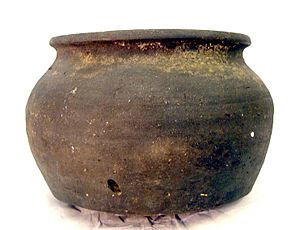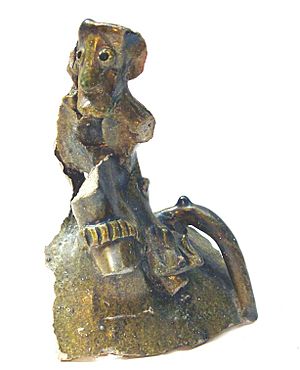Sandy ware facts for kids
Sandy ware, also known as Early Medieval Sandy ware, is a type of pottery found in Great Britain. It was used from the 500s to the 1300s. This pottery is special because it has lots of tiny quartz sand mixed into the clay. You can even see the sand in the pot! Sandy ware was very common in places like Southeast England and the East Midlands.
Contents
What is Sandy Ware?
What makes Sandy ware unique is the sand mixed into the clay. This sand is called 'temper.' It helped the clay stick together when potters were shaping it. It also stopped the pots from cracking while they dried and were baked in a fire. The amount and size of the sand grains changed depending on where and when the pottery was made. At first, these pots were often made by hand or on a slow spinning wheel. They were fired in bonfires. But around the 900s, potters started using faster wheels.
Where and When Was it Found?
Sandy ware has been found all over Great Britain, from the 500s to the 1300s. Over the last 50 years, archaeologists have dug up many important places where this pottery was made and used. These include areas in Southeast England and the East Midlands.
Sandy Ware in Southeast England
Kent
From 2008 to 2010, archaeologists dug at Lyminge, Kent. They found over 6,000 pieces of pottery! Many of these were sandy wares from the 500s to the 900s. The most important finds came from Canterbury. In Canterbury, most of the pottery from the middle to late Anglo-Saxon times was Sandy ware or Shelly ware.
Studies showed that Sandy ware was the most common type of pottery in Kent during the early to middle Anglo-Saxon period. There were three main groups: fine sandy ware, sandy ware, and coarse sandy ware.
At Lyminge, the most common pottery shapes found were jars, cups, and bowls. Most of the pottery pieces had no decoration, or just simple lines scratched into them. Later, in the 700s and 800s, Shelly ware started to become more common than Sandy ware in Kent.
Essex
Essex Micaceous Sandy ware is another type of sandy pottery. It was common in South Cambridgeshire from the 1000s to the 1100s. This pottery is special because it was made with clay that had tiny shiny bits called 'mica' in it. This made the pottery brown or grey-brown. Like most early medieval pottery, Essex sandy ware was made by hand or on a wheel. It felt rough and bumpy. Potters made jars, bowls, spouted bowls, and even curfew bells from it.
London
Early Medieval Sandy ware first appeared in London around the late 900s. Shelly ware was also used a lot at this time. The London sandy ware had many quartz sand grains mixed into its clay. These pots were all made by hand. They had thinner walls and were made a bit more roughly than the later Shelly ware. The shapes of Early Medieval Sandy ware and Early Medieval Sand and Shell ware were similar. Two common sandy ware shapes found in London from this time were the cooking-pot and the shallow dish.
Sandy Ware in the East Midlands
Medieval Sandy Ware first showed up in the East Midlands around the mid-1100s and was common there until the late 1300s. Archaeologists have found many pottery pieces, but it's hard to tell what shapes they were. From the few pieces they could identify, they found bowls, cooking pots, jars, and jugs. This pottery might have been a mix of local sandy ware and some brought in from other places.
There were two main types of Early Medieval ware found here: an older type and a newer type. The older group was made from the 1100s to the 1200s. This pottery was orange to light grey. The light grey pots often had a brownish surface from being baked. The clay had many quartz sand grains. A special feature of this pottery was its 'clubbed rims,' which means the edges of the pots were thick and rounded.
The newer Medieval Sandy ware type was made from the 1200s to the 1300s. It was usually pinkish-orange, sometimes with grey centers. The clay had many quartz sand particles and some tiny iron bits. Some of these pottery pieces even had a pale green glaze on them!
See also
- Shelly ware
- Surrey whiteware
- Border ware
- Humber ware
- List of English medieval pottery




